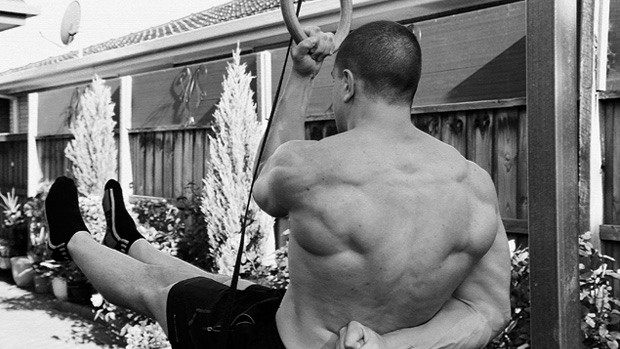It's no longer necessary to be tough to survive.
Living off the land has been replaced with driving to the grocery store, extreme temperatures overcome by furnaces and air conditioners, and defeating illnesses and diseases now can be as simple as taking a pill.
Technology has allowed the weak to thrive as much as the strong, leading to a society that accommodates overeating, under-exercising, and under-stimulating the brain. As a result, the majority of our population is becoming dumber and fatter.
Survival of the fittest no longer applies.
Now ask yourself, when's the last time you really pushed yourself, past the point where your body and mind are screaming for you to stop? Although being physically crushed into the ground isn't something that should be attempted on a regular basis, there's a time and a place for this type of training.
It'll teach you something about yourself. It'll show you how tough you think you are compared to how tough you really are. It can boost your self-confidence – and it can humble you when your ego gets a little uppity.
To investigate this further, I contacted some of the toughest strength and conditioning coaches in the industry for what they thought about the idea of overcoming physical and mental barriers.
Interested in learning about pushing your limits? Read on.
I don't like most "challenge" or "test" workouts much because they seldom test much of anything. They just hurt. It doesn't take any coaching knowledge whatsoever to throw together a random combination of exercises and numbers and then add the words "for time" at the end.
I'm living in a tent in Africa right now and I have a pet monkey named Frankie. If I wanted, I could make a little grid in the sand with exercises and numbers and design my workout based on which ones Frankie left footprints on over the course of an hour.
"Oh, so today we're doing 25 burpees, then 10 pullups, then 35 overhead presses, then... poop, then more burpees...."
I kinda' think, based on the types of routines I'm seeing, that a lot of trainers have pet monkeys.
A common one is doing 100 burpees for time. Well, of course it's hard. They're fucking burpees! But do you have any idea what that's doing to someone's spine?
Go to one of those gyms sometime and watch how those burpees are performed. Violent, uncontrolled lumbar extensionfollowed immediately by a little jump done off the toes, which emphasizes a quad and lumbar dominant movement pattern, flawed mobility, and internal hip rotation.
That pattern will fuck people up, eventually. Why would you want to practice doing it? It's like saying that someone is a good shot with an assault rifle because they can empty their entire magazine really fast towards a target. Did you hit anything? Consider all the variables involved.
A burpee is a simple movement too, and that's the thing. Not many people can actually do simple things well. Basic squats, lunges, pushups, and pull-ups are still flawed in the vast majority of trainees. Each rep is reinforcing a movement pattern and if that pattern is flawed, that "hard workout" is just a setup for long-term movement flaws, limitations, and future injuries.
Now take that movement pattern and put it into a grueling test environment with a bunch of competitive people and you make it even more stressful. For many, being physically tested amongst friends and rivals is one of the most emotionally stressful and genuine experiences they'll have. People want to puke before it even starts because of nervousness and anticipation.
This ingrains these motor patterns in an environment of high emotional stress. However, skill-recall is environmentally specific. If a trainee does ten burpees perfectly in a calm, slow-paced and controlled environment but does them poorly when racing against time and through pain, the only pattern that they're learning to use in the future under stress is the shitty one.
So let's say you do this thing called thinking ahead. You've got someone who wants to perform consistently at a high level of athleticism under any condition. Competitive environments are stressful and as Brasidas of Sparta said, "Fear makes men forget, and skill that cannot fight is useless."
It's not really what you know how to do when it's easy to perform that matters, it's what you're capable of when your world is falling apart and your body is awash in pain.
How do you bridge the gap between low stress performance and high stress performance without ingraining skill degradation? The same way you teach a new trainee how to perform a complex skill in a low-stress environment: Progression.
Think about it, you wouldn't take a brand new trainee and have them start ripping heavy deadlifts off the floor. Similarly, when you begin to progress an athlete into emotionally and physically stressful environments, you must regress the complexity of the skill being practiced in order to first establish a foundation of quality upon which to build.
This means breaking movements down into simpler, more easily reproduced components and developing them individually before integrating them into more complex and technically demanding movements.
The athlete must be able to "turn their brain off" and just go, producing simple, quality movement the whole time.
The patterns or characteristics we're looking for here are things like:
- Glute-Driven Hip Extension. Watch that they aren't trying to dominate the movement with internal hip rotation, knee extension, or lumbar compensation. Very few people are strong enough in their posterior chain relative to their anterior chain.
- Spinal Stability (Lumbar). The lumbar spine should be transmitting force, not generating it. Watch a movement like a burpee. If their spine is flexing like a leaf spring when they hit the bottom, they need to be stopped. Same with deadlifts. It's either high quality or immediately regressed to something simpler.
- Scapular Function. Watch their pullups, pushups, and rows. Are they finishing the pulls by locking their scaps into depression and/or retraction? Are they compensating with protraction, elevation, spinal flexion or by wrenching their humeri beyond a normal range of motion? Are their scaps retracted at the bottom of their pushups or are they winging out?
- Postural Integrity. This is a holistic concept meaning that everything in the body related to joint balance, mobility-stability, and force couples is functioning well. You don't induce an axial load and external rotation on someone with a hunchback and internal humeral rotation by throwing a bar on their back. You're just going to fuck them up.
You have to first break down the foundations of their posture and correct thoracic mobility, scapular function, and internal/external rotator balance. If they begin to regress towards the aforementioned shitty pattern the workout must be stopped and regressed.
All this means that test workouts shouldn't be complicated. This is why we do things like safety bar carries, farmer's walks, and tire drags in the NSW Mile. With a foundation established, dragging a tire, carrying a rickshaw, or walking with a safety bar demands "simple yet difficult" motor patterns to be reproduced. No matter how fast the person goes they should be able to maintain quality of movement long after cognitive function is left behind in a wake of suffering.
Cause what we're really testing here is the mind; the ability to understand that what you're doing hurts and that the only way for it to end is to do it more. This is where you see people break and it's not a physical failure.

The point of all training is growth, specifically psychological growth. Building strength and endurance is dandy but it's EASY. The hard part is what comes next, using one's acquired physical capabilities, testing to learn whether those skills are meaningful.
The really tough part is translating physical capability into equivalent mental horsepower and psychological growth. Nice muscles decorating a 4-bit CPU are like lipstick and perfume on a pig. However, if one develops his or her own multi-core processor then the rest, i.e. the decoration or the physical capability, will follow.
Every meaningful physical achievement that's occurred in or around the Gym Jones project has originated in the mind. It's the only muscle worth training.
One characteristic of a good workout is "The Moment," which is the instant when someone realizes it will be much harder than it appeared, when he or she realizes that pre-workout bravado or confidence in a positive outcome will not be fulfilled.
To cause "The Moment," the workout must last long enough for internal dialogue to begin, for the mind to become adversarial. The trick is to win the negotiation. Feedback is helpful or the opposite.
Let's say the workout is "300 F.Y." which is ride the Airdyne for 10 minutes and to rack up 300 calories in that time. If you do 300, an average power output of 424 watts, you've done the workout. If you do even 299, then Fuck You because you failed.
"The Moment" usually happens four-five minutes into it; if computer feedback shows that the athlete has produced less than 150 calories in the first five minutes, when they were fresh, it's clear the fight will be lost. It's also evident that the fight will continue because no one is allowed to quit.
If "300 F.Y." is too daunting – and anyone familiar with it probably falls into this category – then the following workout developed by Pat O'Shea should satisfy the desire to ruin oneself.
The Workout
| Phase 1 | ||
|---|---|---|
| Exercises | Instructions | |
| 1 | 10 x Hang squat clean @ 50% clean 1RM | 3 sets 2:00 minute rest in-between sets 5 minute break between phases |
| 2 | 2:00 minute AirDyne (target = 90-95% max HR) | |
| Phase 2 | ||
| 1 | 5 x Two-hand KB clean @ 2 x 28-32kg | 3 sets 2:00 minute rest in-between sets 5 minute break between phases |
| 2 | 5 x Two-hand KB jerk @ 2 x 28-32kg | |
| 3 | 2:00 minute row @ >550m Pace | |
| Phase 3 | ||
| 1 | Dumbbell complex (Speed version) @ 2 x 10-15 lbs. DBs | Max Rounds in 90 seconds.
3 sets |
| 2 | 6 x Biceps curl | |
| 3 | 6 x Push press | |
| 4 | 6 x High-Pull | |
| 5 | 6 x Front squat and push press (FSPP) | |
| 6 | 6 x Bent over row + 6 x Upright Row | |
| 7 | 6 x FSPP | |
| 8 | And then, immediately, 6 pull-ups | |
A group of us likes this thing we call "Challenges." About once a month or so, we either get together or just all agree to do the same basic Challenge. My favorite is the 100-rep challenge where we take a serious weight and do 100 singles with it. I've done this with 255 in the front squat, 165 in the squat snatch, 205 in the power clean, and 185 in the power clean and push jerk. It's fun, but very challenging.
Another odd one that I like is we carry out literally everything we have and agree to "do it all." So, that would be med ball throws, Highland Games stuff, farmer bars, sleds, Prowlers, ropes, and assorted junk and stuff. The fun of this is trying to combine as many odd things as you can. Some of my greatest insights in training have come from this simple, fun workout. Having a backpack filled with weights carrying farmer bars is insightful, to say the least.
I don't like to challenge you too much mentally. I want you to finish mentally refreshed, but physically tired. When you review the workout, I want you to be amazed at how much you did, but convinced that not long from now you'll do more and better.
Over the last 13 years working with some of the highest-level mixed martial artists in the world, I've attempted almost every style of training. In particular, I've run the gamut of energy system and metabolic training. Although I feel that this style of training can be overused (especially in preparing high level athletes for competition), I believe that along with training the muscles, nerves and heart, you can also stimulate and challenge the mind.
To that end, I periodically "test" my athletes with challenges designed as much for improving mental toughness as physical performance. One is our infamous New Year's Eve workout. My goal for this (as long as no one has important events upcoming) is to assemble a few of my top athletes from different sports and see how "tough" everyone is.
I'll have players from the NFL, UFC, MLB and major colleges get after it for one day to remind themselves that they're leaving the year stronger (mentally and physically) than they entered it.
Over the years, events have ranged from 40-yard plate push relays to max repetitions or singles in lifts like the bench and deadlift, to circuits composed of bodyweight activities for time. Of all the events, my Category 5 Hurricane still stands out as a time-tested favorite that never ceases to leave athletes gasping with a smile of accomplishment on their faces.
For the Category 5, use a treadmill at 10-20% grade at upwards of 14-15 mph for 30-second sprints (or close to the maximum an athlete can handle). In between sprints, perform two exercises (for example, heavy tire flips and arm over arm pull).
Repeat for three sets and then switch the two exercises (for example, farmer's walks and log clean and presses) for three more sets of alternating sprints and exercises.
Then finish with a final round of more sprints and exercise (sledgehammer swings and chin ups).
So nine total sets of one sprint plus two complex exercises. Usually it takes less than 16 minutes, and usually it takes no prisoners.
I will warn everyone that this style of training isn't to be abused. Any coach can make someone tired, not everyone can improve performance. Don't forget that everything has purpose and we mustn't do something just to kick someone's butt. In the end, the goal of this training is to make the athlete feel tougher – not yourself.
Think you're tough? Looking to test yourself? Or just have nothing better to do? Try any of the above challenges.
A word of caution: It's highly recommended that you try these out with the supervision of a buddy or group of friends. One reason is for safety purposes; the other is so they can drag your sorry ass back when you run away crying and force you to finish.
Use the Forum to post what your hardest physical challenge ever was or try out some of the above challenges and let us know how it went.
Craig Weller spent six years as a Special Warfare Combatant Crewman for the Naval Special Operations Force. You don't come away from that in one piece without being one tough mutha.
Mark Twight is known for the impressive physical transformations of the actors/athletes of the "man-flick" movie 300 and has been training the highest tiers of US military personnel for over a decade. Gym Jones, which he founded with his wife, Lisa, is a training facility dedicated to pushing the bar for toughness back where it belongs.
When Coach Dan John isn't training athletes, writing articles, or speaking at seminars, he's out "paying his dues," whether it's squatting, pulling, pressing, or picking up heavy stuff and walking with it.
Performance enhancement specialist Martin Rooney has trained some of the toughest men (and women) on the planet and has travelled the world in search of finding the most effective and toughest training techniques.





